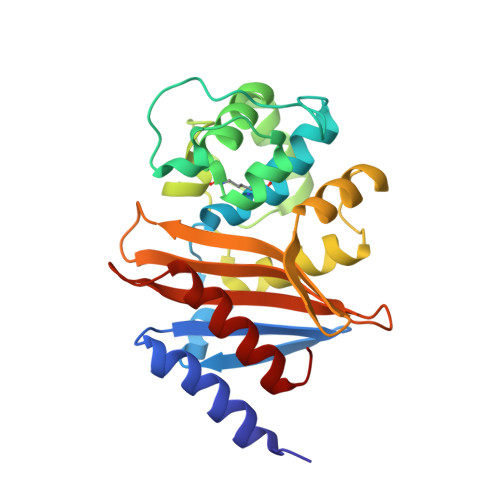Design, synthesis, and crystal structures of 6-alkylidene-2'-substituted penicillanic acid sulfones as potent inhibitors of Acinetobacter baumannii OXA-24 carbapenemase
Bou, G., Santillana, E., Sheri, A., Beceiro, A., Sampson, J.M., Kalp, M., Bethel, C.R., Distler, A.M., Drawz, S.M., Pagadala, S.R., van den Akker, F., Bonomo, R.A., Romero, A., Buynak, J.D.(2010) J Am Chem Soc 132: 13320-13331
- PubMed: 20822105
- DOI: https://doi.org/10.1021/ja104092z
- Primary Citation of Related Structures:
3FV7, 3FYZ, 3FZC, 3G4P, 3MBZ - PubMed Abstract:
Class D β-lactamases represent a growing and diverse class of penicillin-inactivating enzymes that are usually resistant to commercial β-lactamase inhibitors. As many such enzymes are found in multi-drug resistant (MDR) Acinetobacter baumannii and Pseudomonas aeruginosa, novel β-lactamase inhibitors are urgently needed. Five unique 6-alkylidene-2'-substituted penicillanic acid sulfones (1-5) were synthesized and tested against OXA-24, a clinically important β-lactamase that inactivates carbapenems and is found in A. baumannii. Based upon the roles Tyr112 and Met223 play in the OXA-24 β-lactamase, we also engineered two variants (Tyr112Ala and Tyr112Ala,Met223Ala) to test the hypothesis that the hydrophobic tunnel formed by these residues influences inhibitor recognition. IC(50) values against OXA-24 and two OXA-24 β-lactamase variants ranged from 10 ± 1 (4 vs WT) to 338 ± 20 nM (5 vs Tyr112Ala, Met223Ala). Compound 4 possessed the lowest K(i) (500 ± 80 nM vs WT), and 1 possessed the highest inactivation efficiency (k(inact)/K(i) = 0.21 ± 0.02 μM(-1) s(-1)). Electrospray ionization mass spectrometry revealed a single covalent adduct, suggesting the formation of an acyl-enzyme intermediate. X-ray structures of OXA-24 complexed to four inhibitors (2.0-2.6 Å) reveal the formation of stable bicyclic aromatic intermediates with their carbonyl oxygen in the oxyanion hole. These data provide the first structural evidence that 6-alkylidene-2'-substituted penicillin sulfones are effective mechanism-based inactivators of class D β-lactamases. Their unique chemistry makes them developmental candidates. Mechanisms for class D hydrolysis and inhibition are discussed, and a pathway for the evolution of the BlaR1 sensor of Staphylococcus aureus to the class D β-lactamases is proposed.
Organizational Affiliation:
Instituto de Investigación Biomédica de A Coruña (INIBIC), Complejo Hospitalario Universitario A Coruña, 15006-A Coruña, Spain.















